管理信息系统 chapter1
- 格式:pdf
- 大小:75.30 KB
- 文档页数:12
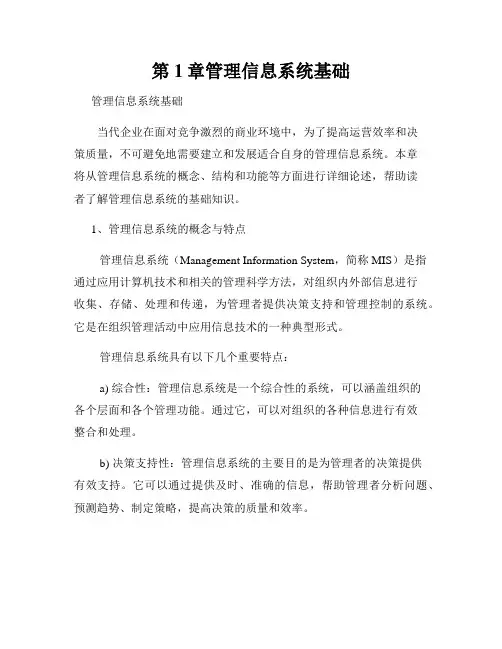
第1章管理信息系统基础管理信息系统基础当代企业在面对竞争激烈的商业环境中,为了提高运营效率和决策质量,不可避免地需要建立和发展适合自身的管理信息系统。
本章将从管理信息系统的概念、结构和功能等方面进行详细论述,帮助读者了解管理信息系统的基础知识。
1、管理信息系统的概念与特点管理信息系统(Management Information System,简称MIS)是指通过应用计算机技术和相关的管理科学方法,对组织内外部信息进行收集、存储、处理和传递,为管理者提供决策支持和管理控制的系统。
它是在组织管理活动中应用信息技术的一种典型形式。
管理信息系统具有以下几个重要特点:a) 综合性:管理信息系统是一个综合性的系统,可以涵盖组织的各个层面和各个管理功能。
通过它,可以对组织的各种信息进行有效整合和处理。
b) 决策支持性:管理信息系统的主要目的是为管理者的决策提供有效支持。
它可以通过提供及时、准确的信息,帮助管理者分析问题、预测趋势、制定策略,提高决策的质量和效率。
c) 自动化处理:管理信息系统采用计算机技术和自动化设备来对信息进行收集、存储和处理。
通过计算机的高速运算和信息处理能力,可以大大提高信息处理的效率和精度。
d) 集成性:管理信息系统可以与组织的其他信息系统进行集成,实现信息的共享和流通。
它与企业资源规划系统、供应链管理系统等的集成,可以打破各个系统之间的信息孤岛,提高整个组织的协同效能。
2、管理信息系统的结构管理信息系统通常由硬件、软件、数据库、网络和人员等多个组成要素构成,形成一个有机的整体。
下面我们将对这些要素逐一进行介绍。
a) 硬件:管理信息系统的硬件包括计算机、服务器、存储设备和输入输出设备等。
这些硬件设备提供了信息处理和存储的基础,是管理信息系统正常运行的支撑。
b) 软件:管理信息系统的软件包括操作系统、数据库管理系统、应用系统等。
这些软件能够实现对信息的处理、存储和检索,为管理者提供各种功能模块和工具。
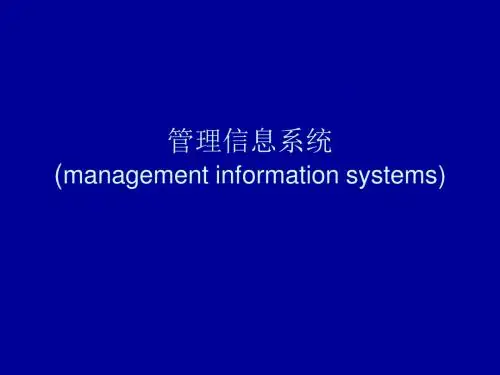
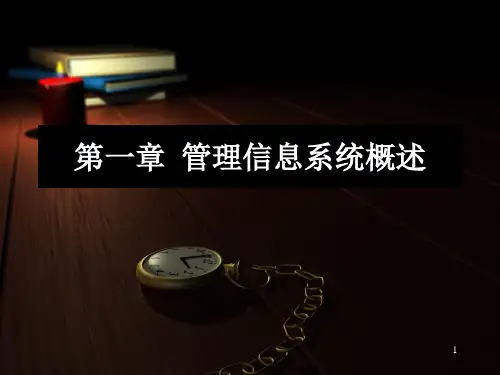
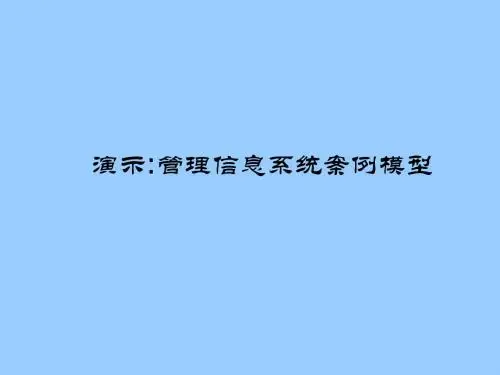
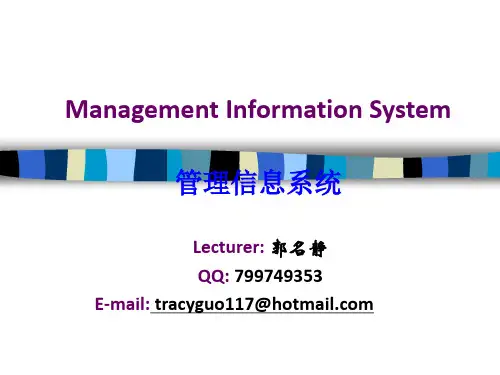
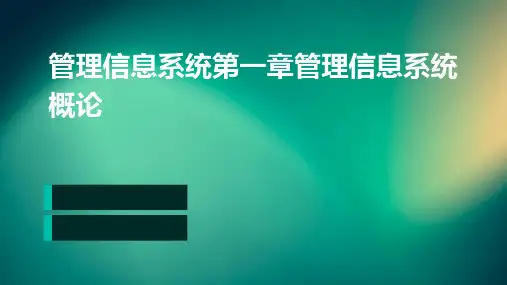
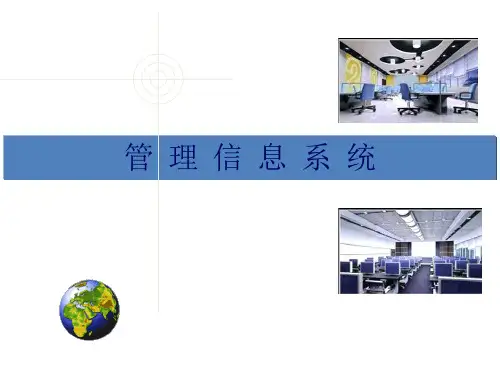
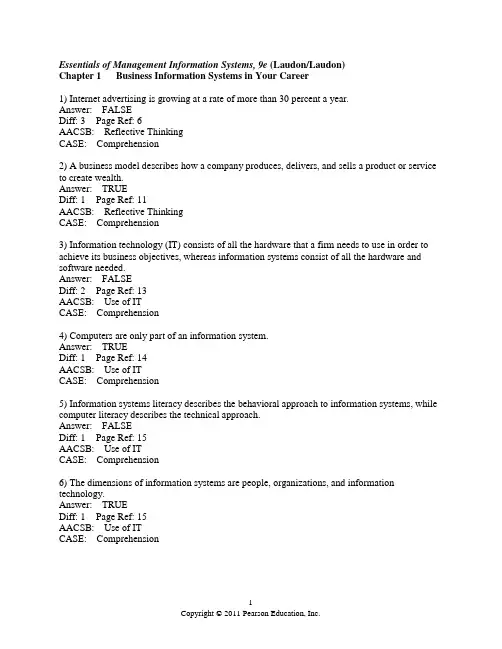
Essentials of Management Information Systems, 9e (Laudon/Laudon)Chapter 1 Business Information Systems in Your Career1) Internet advertising is growing at a rate of more than 30 percent a year.Answer: FALSEDiff: 3 Page Ref: 6AACSB: Reflective ThinkingCASE: Comprehension2) A business model describes how a company produces, delivers, and sells a product or service to create wealth.Answer: TRUEDiff: 1 Page Ref: 11AACSB: Reflective ThinkingCASE: Comprehension3) Information technology (IT) consists of all the hardware that a firm needs to use in order to achieve its business objectives, whereas information systems consist of all the hardware and software needed.Answer: FALSEDiff: 2 Page Ref: 13AACSB: Use of ITCASE: Comprehension4) Computers are only part of an information system.Answer: TRUEDiff: 1 Page Ref: 14AACSB: Use of ITCASE: Comprehension5) Information systems literacy describes the behavioral approach to information systems, while computer literacy describes the technical approach.Answer: FALSEDiff: 1 Page Ref: 15AACSB: Use of ITCASE: Comprehension6) The dimensions of information systems are people, organizations, and information technology.Answer: TRUEDiff: 1 Page Ref: 15AACSB: Use of ITCASE: Comprehension7) In order to understand how a specific business firm uses information systems, you need to know something about the history and culture of the company.Answer: TRUEDiff: 1 Page Ref: 15AACSB: Use of ITCASE: Comprehension8) Developing a new product, fulfilling an order, or hiring a new employee are all examples of business processes.Answer: TRUEDiff: 1 Page Ref: 16AACSB: Reflective ThinkingCASE: Comprehension9) Business processes are those logically related tasks for accomplishing tasks that have been formally encoded by an organization.Answer: FALSEDiff: 2 Page Ref: 16AACSB: Reflective ThinkingCASE: Comprehension10) Employee attitudes about their jobs, employers, or technology can have a powerful effect on their abilities to use information systems productively.Answer: TRUEDiff: 1 Page Ref: 16AACSB: Use of ITCASE: Comprehension11) A network requires at least three computers and a shared resource.Answer: FALSEDiff: 2 Page Ref: 17AACSB: Use of ITCASE: Comprehension12) An IT infrastructure provides the platform on which the firm can build its information systems.Answer: TRUEDiff: 1 Page Ref: 17AACSB: Use of ITCASE: Comprehension13) UPS's use of Web-based tools that allow customers to embed UPS functions such as tracking and cost calculations into their own Web sites was an information systems solution used to achieve customer intimacy.Answer: TRUEDiff: 3 Page Ref: 18AACSB: Analytic SkillsCASE: Comprehension14) Identifying a problem includes agreeing that a problem exists.Answer: TRUEDiff: 1 Page Ref: 21AACSB: Reflective ThinkingCASE: Comprehension15) Political conflict is an example of the people dimension of business problems.Answer: FALSEDiff: 3 Page Ref: 22AACSB: Reflective ThinkingCASE: Comprehension16) As a result of new public laws, accountants are beginning to perform more technical duties, such as auditing systems and networks.Answer: TRUEDiff: 2 Page Ref: 25AACSB: Use of ITCASE: Comprehension17) Forensic accounting is used to investigate bankruptcies and contract disputes.Answer: TRUEDiff: 2 Page Ref: 25AACSB: Reflective ThinkingCASE: Comprehension18) An understanding of enterprise-wide systems for customer relationship management is one of the skills relevant to careers in marketing.Answer: TRUEDiff: 2 Page Ref: 26AACSB: Use of ITCASE: Comprehension19) Whereas marketing and financial careers have been transformed by the growth in information systems, management has–so far–remained relatively unaffected.Answer: FALSEDiff: 2 Page Ref: 26AACSB: Use of ITCASE: Comprehension20) There are two types of outsourcing: offshore outsourcing and foreign outsourcing. Answer: FALSEDiff: 2 Page Ref: 28AACSB: Reflective ThinkingCASE: Comprehension21) As discussed in the chapter opening case, the Yankees' use of information systems in their new stadium can be seen as an effort to achieve which of the primary business objectives?A) Operational excellenceB) SurvivalC) Customer and supplier intimacyD) Improved decision makingAnswer: ADiff: 3 Page Ref: 3-4AACSB: Analytic SkillsCASE: Analysis in terms of categorize22) Journalist Thomas Friedman's description of the world as "flat" referred to:A) the flattening of economic and cultural advantages of developed countries.B) the use of the Internet and technology for instantaneous communication.C) the reduction in travel times and the ubiquity of global exchange and travel.D) the growth of globalization.Answer: ADiff: 2 Page Ref: 9AACSB: Reflective ThinkingCASE: Comprehension23) The six important business objectives of information technology are: new products, services, and business models; customer and supplier intimacy; improved decision-making; competitive advantage; operational excellence, and:A) flexibility.B) survival.C) improved business practices.D) improved efficiency.Answer: BDiff: 2 Page Ref: 10AACSB: Use of ITCASE: Comprehension24) The use of information systems because of necessity describes the business objective of:A) survival.B) improved business practices.C) competitive advantage.D) improved flexibility.Answer: ADiff: 2 Page Ref: 12AACSB: Use of ITCASE: Comprehension25) Which of the following choices may lead to competitive advantage (1) new products, services, and business models; (2) charging less for superior products; (3) responding to customers in real-time?A) 1 onlyB) 1 and 2C) 2 and 3D) 1, 2, and 3Answer: DDiff: 3 Page Ref: 12AACSB: Analytic SkillsCASE: Analysis in terms of compare26) Verizon's implementation of a Web-based digital dashboard to provide managers withreal-time information such as customer complaints is an example of:A) improved flexibility.B) improved decision-making.C) improved efficiency.D) customer and supplier intimacy.Answer: BDiff: 2 Page Ref: 12AACSB: Use of ITCASE: Analysis in terms of categorize27) The move of retail banking to use ATMs after Citibank unveiled its first ATMs illustrates the information system business objective of:A) improved efficiency.B) customer and supplier intimacy.C) survival.D) competitive advantage.Answer: CDiff: 2 Page Ref: 12AACSB: Use of ITCASE: Analysis in terms of categorize28) An information system can be defined technically as a set of interrelated components that collect (or retrieve), process, store, and distribute information to support:A) decision making and control in an organization.B) communications and data flow.C) managers analyzing the organization's raw data.D) the creation of new products and services.Answer: ADiff: 2 Page Ref: 13AACSB: Use of ITCASE: Comprehension29) The three activities in an information system that produce the information organizations use to control operations are:A) information retrieval, research, and analysis.B) input, output, and feedback.C) input, processing, and output.D) data analysis, processing, and feedback.Answer: CDiff: 1 Page Ref: 14AACSB: Use of ITCASE: Comprehension30) Order data for baseball tickets and bar code data are examples of:A) raw input.B) raw output.C) customer and product data.D) sales information.Answer: ADiff: 1 Page Ref: 14AACSB: Analytic SkillsCASE: Analysis in terms of categorize31) The average number of tickets sold daily online is an example of:A) input.B) raw data.C) meaningful information.D) output.Answer: CDiff: 1 Page Ref: 14AACSB: Analytic SkillsCASE: Analysis in terms of categorize32) Output:A) is feedback that has been processed to create meaningful information.B) is information that is returned to appropriate members of the organization to help them evaluate the input stage.C) transfers raw data to the people who will use it or to the activities for which it will be used.D) transfers processed information to the people who will use it or to the activities for which it will be used.Answer: DDiff: 1 Page Ref: 14AACSB: Reflective ThinkingCASE: Comprehension33) Converting raw data into a more meaningful form is called:A) capturing.B) processing.C) organizing.D) feedback.Answer: BDiff: 1 Page Ref: 14AACSB: Reflective ThinkingCASE: Comprehension34) An example of raw data from a national chain of automobile stores would be:A) average of 13 Toyotas sold daily in Kentucky in 2007.B) 300 Toyota RAV4s sold during fourth quarter 2007 in Kentucky.C) 1 Toyota RAV4 sold January 7, 2008 in Louisville, Kentucky - $28000.D) annual sales of Toyota RAV4s increased 2.4 percent.Answer: CDiff: 3 Page Ref: 14AACSB: Analytic SkillsCASE: Analysis in terms of categorize35) Electronic computers and related software programs are the technical foundation, the tools and materials, of:A) all business procedures.B) information accumulation.C) modern information systems.D) all industrialized countries.Answer: CDiff: 2 Page Ref: 14-15AACSB: Reflective ThinkingCASE: Comprehension36) The field that deals with behavioral issues as well as technical issues surrounding the development, use, and impact of information systems used by managers and employees in the firm is called:A) information systems literacy.B) information systems architecture.C) management information systems.D) information technology infrastructure.Answer: CDiff: 2 Page Ref: 15AACSB: Reflective ThinkingCASE: Comprehension37) A hierarchy:A) results in a clear-cut division of labor.B) is composed primarily of experts trained for different functions.C) is a pyramid structure of rising authority and responsibility.D) is used primarily in large organizations to define job roles.Answer: CDiff: 1 Page Ref: 15AACSB: Reflective ThinkingCASE: Comprehension38) In a hierarchical organization, the upper levels consist of:A) managerial and professional workers.B) managerial, professional, and technical workers.C) professional and operational workers.D) managerial, professional, and operational workers.Answer: BDiff: 2 Page Ref: 15-16AACSB: Reflective ThinkingCASE: Comprehension39) The fundamental set of assumptions, values, and ways of doing things that has been accepted by most of a company's members is called its:A) culture.B) environment.C) atmosphere.D) values.Answer: ADiff: 1 Page Ref: 16AACSB: Reflective ThinkingCASE: Comprehension40) Business processes:A) include informal work practices.B) are used primarily for sales and accounting functions.C) are governed by information technology.D) are logically related tasks used primarily by operational personnel.Answer: ADiff: 1 Page Ref: 16AACSB: Reflective ThinkingCASE: Comprehension41) Data management technology consists of:A) the physical hardware and media used by an organization for storing data.B) the detailed, preprogrammed instructions that control and coordinate the computer hardware components in an information system.C) the software governing the organization of data on physical storage media.D) the hardware and software used to transfer data.Answer: CDiff: 2 Page Ref: 17AACSB: Use of ITCASE: Comprehension42) The hardware and software used to transfer data in an organization is called:A) data management technology.B) networking and data management technology.C) data and telecommunications technology.D) networking and telecommunications technology.Answer: DDiff: 2 Page Ref: 17AACSB: Use of ITCASE: Comprehension43) An intranet uses:A) mainframe technology.B) infrared telecommunications systems.C) the telecommunications capacities of fiber optic networks.D) Internet technology within the boundaries of the firm.Answer: DDiff: 2 Page Ref: 17AACSB: Use of ITCASE: Comprehension44) The first step in the four-step model of business problem solving is:A) agreeing that a problem exists.B) identifying the problem.C) outlining the problem's causes.D) assigning the problem to a problem solver.Answer: BDiff: 1 Page Ref: 21AACSB: Reflective ThinkingCASE: Comprehension45) Inadequate database capacity is an example of the ________ dimension of business problems.A) technologyB) organizationalC) peopleD) managementAnswer: ADiff: 2 Page Ref: 20AACSB: Analytic SkillsCASE: Analysis in terms of categorize46) Legal and regulatory compliance is an example of the ________ dimension of business problems.A) managementB) organizationalC) peopleD) technologyAnswer: CDiff: 3 Page Ref: 22AACSB: Analytic SkillsCASE: Analysis in terms of categorize47) Aging hardware and outdated software are examples of the ________ dimension of business problems.A) technologyB) managementC) information systemsD) organizationalAnswer: ADiff: 1 Page Ref: 22AACSB: Analytic SkillsCASE: Analysis in terms of categorize48) Poor business processes and unsupportive culture are examples of the ________ dimension of business problems.A) managementB) organizationalC) peopleD) infrastructureAnswer: BDiff: 2 Page Ref: 22AACSB: Analytic SkillsCASE: Analysis in terms of categorize49) The owners of Speed-EZ, a new bike messenger service, are concerned about how they will manage their messengers once they have left the office. This is a business problem that falls into the:A) management dimension.B) people dimension.C) organizational dimension.D) technology dimension.Answer: BDiff: 3 Page Ref: 20AACSB: Analytic SkillsCASE: Analysis in terms of categorize50) Flapjack Flats, a new pancake chain, is having difficulty finding pancake chefs. This is a business problem that falls into the:A) management dimension.B) people dimension.C) organizational dimension.D) technical dimension.Answer: CDiff: 3 Page Ref: 22AACSB: Reflective ThinkingCASE: Analysis in terms of categorize51) In choosing the best solution for a business problem, one of the most important considerations is:A) change management.B) existing resources and skills.C) employee training.D) outcome measurement.Answer: BDiff: 3 Page Ref: 22AACSB: Analytic SkillsCASE: Synthesis in terms of predicting52) The final step in the four-step model of business problem solving is:A) outcome.B) implementation.C) change management.D) feedback.Answer: BDiff: 1 Page Ref: 22AACSB: Reflective ThinkingCASE: Comprehension53) Which of the following would not be considered part of the implementation phase of problem solving?A) change managementB) purchasing hardware for an information systems solutionC) training an employee on new systems softwareD) evaluating a selection of software packages for implementing a new business process Answer: DDiff: 2 Page Ref: 22-23AACSB: Analytic SkillsCASE: Analysis in terms of categorize54) The failure of NASA's initial solution to preventing the space shuttle shedding foam illustrates:A) the importance of training employees on new business processes.B) the need to prepare for measuring outcomes of a business solution.C) the continuous nature of problem solving.D) the need to quickly adapt to new technological innovations.Answer: CDiff: 2 Page Ref: 23AACSB: Analytic SkillsCASE: Analysis in terms of compare55) One of the most frequent errors in problem solving is:A) rushing to judgment.B) not being aware of personal limitations.C) being too doubtful.D) following a rote pattern of decision making.Answer: ADiff: 2 Page Ref: 23AACSB: Reflective ThinkingCASE: Comprehension56) A major criterion in deciding the most important perspectives of a business problem is:A) implementation.B) change management.C) usefulness.D) organizational needs.Answer: CDiff: 3 Page Ref: 24AACSB: Reflective ThinkingCASE: Comprehension57) Which of the following is an example of a business using information systems to create new products and services?A) Apple's creation of the iPodB) JC Penney's information system that allows its contract manufacturers to see what garments have been sold and need to be replacedC) Toyota's legendary TPS that has created superlative efficiencies and enabled Toyota to become the world's largest auto makerD) Verizon's Web-based digital dashboard providing real-time company information for managersAnswer: ADiff: 2 Page Ref: 11AACSB: Analytic SkillsCASE: Analysis in terms of categorize58) An example of a business using information systems to attain competitive advantage is:A) Apple's creation of the iPod.B) JC Penney's information system that allows its contract manufacturers to see what garments have been sold and need to be replaced.C) Toyota's legendary TPS that has created superlative efficiencies and enabled Toyota to become the world's largest auto maker.D) Verizon's Web-based digital dashboard providing real-time company information for managers.Answer: CDiff: 2 Page Ref: 12AACSB: Use of ITCASE: Analysis in terms of categorize59) An example of a business using information systems for customer and supplier intimacy is:A) Apple's creation of the iPod.B) JC Penney's information system that allows its contract manufacturers to see what garments have been sold and need to be replaced.C) Toyota's legendary TPS that has created superlative efficiencies and enabled Toyota to become the world's largest auto maker.D) Verizon's Web-based digital dashboard providing real-time company information for managers.Answer: BDiff: 2 Page Ref: 11AACSB: Analytic SkillsCASE: Analysis in terms of categorize60) An information skill important for an accounting major would be:A) an understanding of system and network security issues.B) an understanding of product management enterprise systems.C) an understanding of supplier management enterprise systems.D) an understanding of enterprise systems that enhance leadership.Answer: ADiff: 3 Page Ref: 25AACSB: Reflective ThinkingCASE: Comprehension61) An information skill important for a marketing major would be:A) an understanding of system and network security issues.B) an understanding of product management enterprise systems.C) an understanding of supplier management enterprise systems.D) an understanding of enterprise systems that enhance leadership.Answer: BDiff: 2 Page Ref: 26AACSB: Reflective ThinkingCASE: Comprehension62) Maintaining the organization's financial records is a business function of:A) accounting.B) financeC) salesD) marketing.Answer: ADiff: 1 Page Ref: 25AACSB: Reflective ThinkingCASE: Comprehension63) Branding products is a business function of:A) manufacturing and production.B) finance and accounting.C) human resources.D) marketing.Answer: DDiff: 1 Page Ref: 26AACSB: Reflective ThinkingCASE: Comprehension64) To make sure they stock clothes that their customers will purchase, a department store implements a new application that analyzes spending levels at their stores and cross-references this data to popular clothing styles. This is an example of using information systems to support a business strategy of:A) new products, services, and business models.B) survival.C) customer and supplier intimacy.D) improved decision making.Answer: CDiff: 2 Page Ref: 11AACSB: Analytic SkillsCASE: Analysis in terms of categorize65) Financial managers work directly with ________ to ensure investments in information systems help achieve corporate goals.A) operations managersB) senior managersC) marketing managersD) accounting managersAnswer: BDiff: 2 Page Ref: 26AACSB: Reflective ThinkingCASE: Comprehension66) Operations management as a discipline is directly relevant to three occupational categories:A) industrial production managers, operations analysts, and administrative service managers.B) project managers, production managers, and administrative service managers.C) project managers, production managers, and industrial production managers.D) finance, accounting, and management.Answer: ADiff: 2 Page Ref: 26-27AACSB: Reflective ThinkingCASE: Comprehension67) Assume you work for a package delivery service in a major metropolitan area, and that the business has been losing customers for several years. You have been asked to find a solution to this problem, perhaps one which uses modern information technologies. What is the correct way to proceed?A) Look for solutions, evaluate the solutions, identify the problem more clearly, and then implement the solution.B) Think about what solutions can be implemented, look for solution designs, evaluate the designs, and then implement the solution.C) Identify the problem, design alternative solutions, choose the best solution, and then implement the solution.D) Design solutions, evaluate and identify the problems, choose the best solution, and then implement the solution.Answer: CDiff: 2 Page Ref: 20-21AACSB: Analytic SkillsCASE: Analysis in terms of organizing68) Which of the following statements is not true?A) The most common and successful offshore outsourcing projects involve production programming and system maintenance programming work, along with call center work.B) Inflation in Indian wages for technology work is leading to a counter movement of jobs back to the United States.C) The fear that offshore outsourcing will reduce demand for new information system hires in the U.S. is mitigated by the fact that reduced IT expenditures results in increased IT investments and the creation of domestic jobs.D) The impact of domestic IT outsourcing has been very disruptive to some regional areas of the U.S.Answer: DDiff: 2 Page Ref: 28AACSB: Reflective ThinkingCASE: Comprehension69) The culture of UPS places service to the customer among the company's highest business objectives, which is reflected in their use of information systems to enable customer tracking of their packages. Based on your reading of Chapter 1, why is "culture" an important factor to consider when building information system solutions to business problems?A) Business culture has to be synchronized with new technology.B) The business culture provides the vision and inspiration for information system solutions.C) People are a company's most important asset.D) Businesses without culture do not understand new technology.Answer: BDiff: 3 Page Ref: 15-16AACSB: Analytic SkillsCASE: Evaluation in terms of assess70) Based on your reading of the case discussing mobile handhelds, Doylestown Hospital's use of iPhones is an example of using information systems to enhance which of the following generic business objectives?A) SurvivalB) New products, services, and business modelsC) Improved decision makingD) Customer and supplier intimacyAnswer: CDiff: 3 Page Ref: 8AACSB: Analytic SkillsCASE: Evaluation in terms of categorize71) ________ is data that has been shaped into a form that is meaningful to human beings. Answer: InformationDiff: 1 Page Ref: 13AACSB: Reflective ThinkingCASE: Comprehension72) ________ is output returned to appropriate members of the organization to help them evaluate or correct the input stage.Answer: FeedbackDiff: 2 Page Ref: 14AACSB: Reflective ThinkingCASE: Comprehension73) The world's largest and most widely used network is ________.Answer: the InternetDiff: 1 Page Ref: 17AACSB: Reflective ThinkingCASE: Comprehension74) ________ consists of the detailed, preprogrammed instructions that control and coordinate the computer hardware components in an information system.Answer: Computer software/softwareDiff: 1 Page Ref: 17AACSB: Reflective ThinkingCASE: Comprehension75) The ________ is a service provided by the Internet that uses universally accepted standards for storing, retrieving, formatting, and displaying information in a page format.Answer: World Wide Web/Web/WWWDiff: 1 Page Ref: 17AACSB: Reflective ThinkingCASE: Comprehension76) ________ are private corporate networks extended to authorized users outside the organization.Answer: ExtranetsDiff: 1 Page Ref: 17AACSB: Reflective ThinkingCASE: Comprehension77) In business problem solving, the three major categories of factors are organization, technology, and ________.Answer: peopleDiff: 2 Page Ref: 20AACSB: Reflective ThinkingCASE: Comprehension78) Having inadequate resources is a business problem that falls into the ________ dimension. Answer: organizationalDiff: 3 Page Ref: 22AACSB: Reflective ThinkingCASE: Comprehension79) Encouraging employees to adapt to new business processes is one factor of ________. Answer: change managementDiff: 3 Page Ref: 23AACSB: Reflective ThinkingCASE: Comprehension80) Being aware of organizational and personal limitations is one of the four elements of________.Answer: critical thinking.Diff: 2 Page Ref: 23AACSB: Reflective ThinkingCASE: Comprehension81) Define operational excellence. How can information systems help achieve it?Answer: Operational excellence is the achievement of higher levels of productivity and efficiency. Information systems can help achieve operational excellence by improving communications to supplier and optimizing the supply chain. Information systems could help managers communicate with workers more efficiently, enable technological innovation in products, minimize warehouse overhead, streamline distribution.Diff: 2 Page Ref: 10-11AACSB: Use of ITCASE: Synthesis in terms of devising82) You work for an auto manufacturer and distributor. How could you use information systems to achieve greater customer intimacy?Answer: You could create a web site that allows customers to customize cars, communicate with support personnel and other car owners. You could create an automated e-mail service reminding car owners to take their car in for periodic check ups. You could have an information system that tracks customer preferences in local areas, so you can provide cars that reflect local customer needs and desires.Diff: 2 Page Ref: 11-12AACSB: Reflective ThinkingCASE: Synthesis in terms of applying83) What important managerial function is impaired by not having access to timely and accurate information? What is the effect of this lack of data?Answer: The managerial function is decision-making. Without access to timely and accurate information business managers rely on forecasts, best guesses, and luck. The result is over- or underproduction of goods and services, misallocation of resources, and poor response times. These poor outcomes raise costs and lose customers.Diff: 2 Page Ref: 12AACSB: Use of ITCASE: Evaluation in terms of justify84) What is the difference between information technology and information systems? Describe some of the functions of information systems.Answer: Information technology (IT) consists of all the hardware and software that a firm needs to use in order to achieve its business objectives. Information systems are more complex. An information system can be defined technically as a set of interrelated components that collect (or retrieve), process, store, and distribute information to support decision making and control in an organization.The functions of an information system are to support decision making, coordination, and control; help employees analyze problems; help employees visualize complex subjects; and help create new products.Diff: 2 Page Ref: 13AACSB: Use of ITCASE: Synthesis in terms of applying, generalizing85) You are a marketing manager for a national movie theater chain. Give an example of data that your department could use for creating meaningful information. What type of information could that data produce?Answer: Movie ticket sales from individual theaters would be an example of raw data. Meaningful information from this would be: average number of tickets sold to seniors on certain days of the week.Diff: 1 Page Ref: 13-14AACSB: Use of ITCASE: Synthesis in terms of devising。
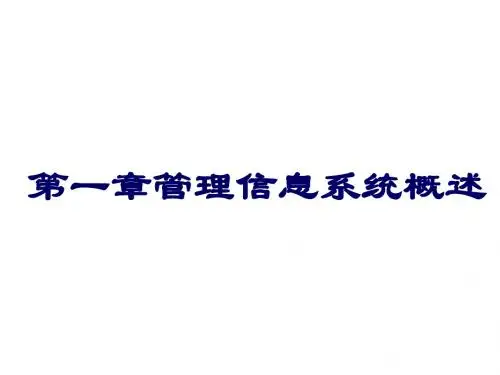
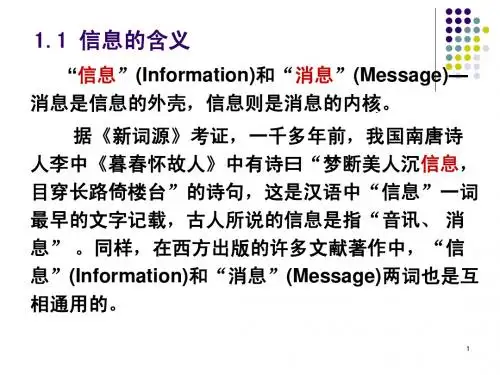
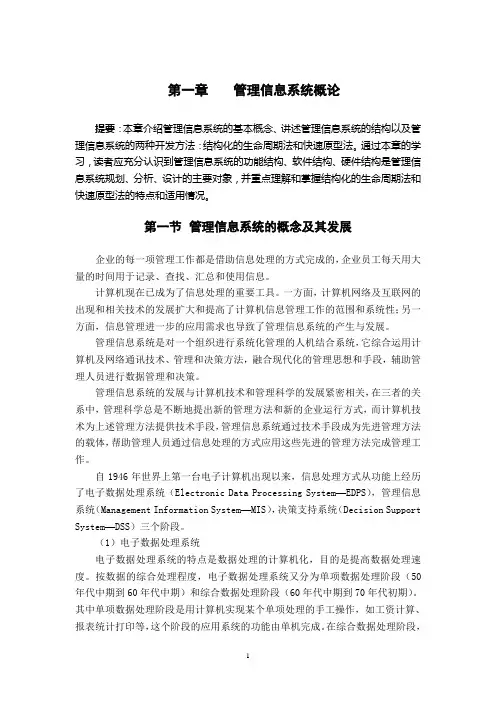
第一章管理信息系统概论提要:本章介绍管理信息系统的基本概念、讲述管理信息系统的结构以及管理信息系统的两种开发方法:结构化的生命周期法和快速原型法。
通过本章的学习,读者应充分认识到管理信息系统的功能结构、软件结构、硬件结构是管理信息系统规划、分析、设计的主要对象,并重点理解和掌握结构化的生命周期法和快速原型法的特点和适用情况。
第一节管理信息系统的概念及其发展企业的每一项管理工作都是借助信息处理的方式完成的,企业员工每天用大量的时间用于记录、查找、汇总和使用信息。
计算机现在已成为了信息处理的重要工具。
一方面,计算机网络及互联网的出现和相关技术的发展扩大和提高了计算机信息管理工作的范围和系统性;另一方面,信息管理进一步的应用需求也导致了管理信息系统的产生与发展。
管理信息系统是对一个组织进行系统化管理的人机结合系统,它综合运用计算机及网络通讯技术、管理和决策方法,融合现代化的管理思想和手段,辅助管理人员进行数据管理和决策。
管理信息系统的发展与计算机技术和管理科学的发展紧密相关,在三者的关系中,管理科学总是不断地提出新的管理方法和新的企业运行方式,而计算机技术为上述管理方法提供技术手段,管理信息系统通过技术手段成为先进管理方法的载体,帮助管理人员通过信息处理的方式应用这些先进的管理方法完成管理工作。
自1946年世界上第一台电子计算机出现以来,信息处理方式从功能上经历了电子数据处理系统(Electronic Data Processing System—EDPS),管理信息系统(Management Information System—MIS),决策支持系统(Decision Support System—DSS)三个阶段。
(1)电子数据处理系统电子数据处理系统的特点是数据处理的计算机化,目的是提高数据处理速度。
按数据的综合处理程度,电子数据处理系统又分为单项数据处理阶段(50年代中期到60年代中期)和综合数据处理阶段(60年代中期到70年代初期)。
Management Information SystemsChapter 1 Information Systems in Global Business Today1) The six important business objectives of information technology are new products, services, and business models; customer and supplier intimacy; survival; competitive advantage; operational excellence; andA) improved flexibility.B) improved decision making.C) improved business practices.D) improved efficiency.E) improved business value.Answer: BPage Ref: 44-47Difficulty: EasyAACSB: Information technologyCASE: ConceptLO: 1.1: How are information systems transforming business, and why are they so essential for running and managing a business today?2) Which of the following choices may lead to competitive advantage?1. new products, services, and business models;2. charging less for superior products;3. responding to customers in real time?A) 1 onlyB) 1 and 2C) 2 and 3D) 1 and 3E) 1, 2, and 3Answer: EPage Ref: 47, PPT1.15Difficulty: DifficultAACSB: Analytical thinkingCASE: ApplicationLO: 1.1: How are information systems transforming business, and why are they so essential for running and managing a business today?3) The Mandarin Oriental hotel's use of computer systems to keep track of guests' preferences is an example ofA) improved flexibility.B) improved decision making.C) improved efficiency.D) customer and supplier intimacy.E) operational excellence.Answer: DPage Ref: 46Difficulty: ModerateAACSB: Information technologyCASE: ApplicationLO: 1.1: How are information systems transforming business, and why are they so essential forrunning and managing a business today?4) Which of the following objectives best describes the business strategy behind the technologies implemented by the San Francisco Giants, as discussed in the chapter case?A) customer and supplier intimacyB) survivalC) competitive advantageD) customer supportE) operational excellenceAnswer: CPage Ref:Difficulty: ModerateAACSB: Analytical thinkingCASE: ApplicationLO: 1.1: How are information systems transforming business, and why are they so essential for running and managing a business today?5) An example of a business using information systems to attain operational excellence isA) Wal-Mart's Retail Link system.B) the Mandarin Oriental hotel's customer-preference tracking system.C) Verizon's Web-based digital dashboard.D) Apple Inc.'s iPod.E) Citibank's ATMs.Answer: APage Ref: 46Difficulty: DifficultAACSB: Information technologyCASE: ApplicationLO: 1.1: How are information systems transforming business, and why are they so essential for running and managing a business today?6) The temp agency that you own is having serious difficulties placing temps because few of them are familiar with Internet research. Investing in training software to enhance your workers' skills is an example of using technology to achieve which business objective?A) customer and supplier intimacyB) survivalC) operational excellenceD) improved decision makingE) new products and servicesAnswer: BPage Ref: 47Difficulty: ModerateAACSB: Analytical thinkingCASE: SynthesisLO: 1.1: How are information systems transforming business, and why are they so essential for running and managing a business today?7) All of the following are advantages, for a firm, of cloud computing exceptA) ability to support mobile computing.B) ability to support remote work.C) ability to improve communication.D) ability to rely on markets to build value.E) ability to reduce data storage costs.Answer: CPage Ref: 39, 40Difficulty: ModerateAACSB: Analytical thinkingCASE: SynthesisLO: 1.1: How are information systems transforming business, and why are they so essential for running and managing a business today?8) A firm that must invest in new information systems capabilities in order to comply with federal legislation can be said to be investing to achieve which business objective?A) customer intimacyB) operational excellenceC) survivalD) improved reportingE) improved decision makingAnswer: CPage Ref: 47Difficulty: ModerateAACSB: Information technologyCASE: ApplicationLO: 1.1: How are information systems transforming business, and why are they so essential for running and managing a business today?9) Order data for baseball tickets and bar code data are examples ofA) raw input.B) raw output.C) customer and product data.D) sales information.E) information systems.Answer: APage Ref: 49Difficulty: EasyAACSB: Information technologyCASE: ConceptLO: 1.2: What is an information system? How does it work? What are its management, organization, and technology components and why are complementary assets essential for ensuring that information systems provide genuine value for organizations?14) OutputA) is feedback that has been processed to create meaningful information.B) is information that is returned to appropriate members of the organization to help them evaluate the input stage.C) transfers data to the people who will use it or to the activities for which it will be used.D) transfers processed information to the people who will use it or to the activities for which it will be used.E) converts raw input into a meaningful form.Answer: DPage Ref: 49, PPT1.19Difficulty: EasyAACSB: Information technologyCASE: ConceptLO: 1.2: What is an information system? How does it work? What are its management, organization, and technology components and why are complementary assets essential for ensuring that information systems provide genuine value for organizations?11) An example of raw data from a national chain of automobile stores would beA) an average of 13 Toyotas are sold daily in Kentucky.B) 30-percent increase in Toyota RAV4 sales during September in Kentucky.C) 1 Toyota RAV4 sold March 3, 2013, in Louisville, Kentucky.D) 10-percent improvement in sales projections for Toyota sales next year.E) a demographic breakdown of all Toyota buyers in the past year.Answer: CPage Ref: 48、49Difficulty: DifficultAACSB: Information technologyCASE: ApplicationLO: 1.2: What is an information system? How does it work? What are its management, organization, and technology components and why are complementary assets essential for ensuring that information systems provide genuine value for organizations?12) Which of the following is not one of the current changes taking place in information systems technology?A) growing business use of "big data"B) growth in cloud computingC) growth in the PC platformD) emerging mobile platformE) increased usage of social networking by businessAnswer: CPage Ref: 39Difficulty: ModerateAACSB: Reflective thinkingCASE: ConceptLO: 1.2: What is an information system? How does it work? What are its management, organization, and technology components and why are complementary assets essential for ensuring that information systems provide genuine value for organizations?13) Thomas Friedman's declaration that the world was now "flat" meant thatA) the Internet has reduced the economic advantages of developed countries.B) globalization is starting to offer less advantage to large corporations.C) the global economy is increasingly commanded by fewer and larger corporations.D) global capitalism is homogenizing culture and business practices throughout the world.E) global shipping rates have reached historic lows.Answer: APage Ref: 43Difficulty: EasyAACSB: Reflective thinkingCASE: ConceptLO: 1.2: What is an information system? How does it work? What are its management, organization, and technology components and why are complementary assets essential for ensuring that information systems provide genuine value for organizations?14) Which of the following statements best describes organizational culture?A) It encompasses the sum of beliefs and assumptions by all members.B) It enables the organization to transcend the different levels and specialties of its employees.C) It reflects the senior management's perspective on the organization and goals.D) It allows a company to achieve greater operational efficiency.E) It is a set of assumptions and values accepted by most members.Answer: EPage Ref: 52Difficulty: ModerateAACSB: Analytical thinkingCASE: ApplicationLO: 1.2: What is an information system? How does it work? What are its management, organization, and technology components and why are complementary assets essential for ensuring that information systems provide genuine value for organizations?15) Maintaining the organization's financial records is a central purpose of which main business function?A) manufacturing and accountingB) finance and accountingC) sales and manufacturingD) finance and salesE) human resourcesAnswer: BPage Ref: 52Difficulty: EasyAACSB: Reflective thinkingCASE: ConceptLO: 1.2: What is an information system? How does it work? What are its management, organization, and technology components and why are complementary assets essential for ensuring that information systems provide genuine value for organizations?16) Which of the following best describes the primary reason for implementing a new information system, from a business perspective?A) The system enables the firm to create new products and services.B) The system will create new value for the firm, beyond its costs.C) The system will automate key business processes.D) The system is in use by our primary competitors.E) The system integrates well with the Web.Answer: BPage Ref: 57Difficulty: ModerateAACSB: Information technologyCASE: SynthesisLO: 1.2: What is an information system? How does it work? What are its management, organization, and technology components and why are complementary assets essential for ensuring that information systems provide genuine value for organizations?17) In a business hierarchy, the level that is responsible for monitoring the daily activities of the business isA) middle management.B) service workers.C) production management.D) operational management.E) knowledge workers.Answer: DPage Ref: 51Difficulty: ModerateAACSB: Reflective thinkingCASE: ConceptLO: 1.2: What is an information system? How does it work? What are its management, organization, and technology components and why are complementary assets essential for ensuring that information systems provide genuine value for organizations?18) A corporation that funds a political action committee, which in turn promotes and funds a political candidate who agrees with the values of that corporation, could be seen as investing in which main category of complementary assets?A) managerialB) governmentalC) socialD) organizationalE) auxiliaryAnswer: CPage Ref: 60Difficulty: ModerateAACSB: Analytical thinkingCASE: ApplicationLO: 1.2: What is an information system? How does it work? What are its management, organization, and technology components and why are complementary assets essential for ensuring that information systems provide genuine value for organizations?19) An example of a social complementary asset isA) technology and service firms in adjacent markets.B) training programs.C) distributed decision-making rights.D) incentives for management innovation.E) a strong IS development team.Answer: APage Ref: 60、59Difficulty: ModerateAACSB: Reflective thinkingCASE: ConceptLO: 1.2: What is an information system? How does it work? What are its management, organization, and technology components and why are complementary assets essential for ensuring that information systems provide genuine value for organizations?20) Which of the following would not be used as an input for an information system?A) digital dashboardB) handheld computerC) barcode scannerD) cell phoneE) RFID readingAnswer: APage Ref: 48-49Difficulty: ModerateAACSB: Information technologyCASE: ApplicationLO: 1.2: What is an information system? How does it work? What are its management, organization, and technology components and why are complementary assets essential for ensuring that information systems provide genuine value for organizations?21) Engineers, scientists, or architects, who design new products or services for a firm, belong to which level of a business hierarchy?A) middle managementB) production workersC) knowledge workersD) data workersE) service workersAnswer: CPage Ref: 51Difficulty: ModerateAACSB: Reflective thinkingCASE: ConceptLO: 1.2: What is an information system? How does it work? What are its management, organization, and technology components and why are complementary assets essential for ensuring that information systems provide genuine value for organizations?22) Which of the following constitutes an organizational element in the UPS tracking system described in the chapter?A) the specification of procedures for identifying packages with sender and recipient informationB) monitoring service levelsC) promoting the company strategy of low-cost, superior serviceD) the use of handheld computers and networks for managing package deliveryE) a Web-based Post Sales Order Management SystemAnswer: APage Ref: 54-56Difficulty: DifficultAACSB: Analytical thinkingCASE: SynthesisLO: 1.2: What is an information system? How does it work? What are its management, organization, and technology components and why are complementary assets essential for ensuring that information systems provide genuine value for organizations?23) Disciplines that contribute to the technical approach to information systems areA) computer science, engineering, and networking.B) operations research, management science, and computer science.C) engineering, utilization management, and computer science.D) management science, computer science, and engineering.E) economics, sociology, and psychology.Answer: BPage Ref: 61Difficulty: DifficultAACSB: Information technologyCASE: ConceptLO: 1.3: What academic disciplines are used to study information systems and how does each contribute to an understanding of information systems?24) Sociologists study information systems with an eye to understandingA) how systems affect individuals, groups, and organizations.B) how human decision makers perceive and use formal information.C) how new information systems change the control and cost structures within the firm.D) the production of digital goods.E) mathematically based models and physical technology.Answer: APage Ref: 62Difficulty: ModerateAACSB: Information technologyCASE: ConceptLO: 1.3: What academic disciplines are used to study information systems and how does each contribute to an understanding of information systems?25) Which field of study focuses on both a behavioral and technical understanding of information systems?A) sociologyB) operations researchC) economicsD) behavioral computingE) management information systemsAnswer: EPage Ref: 61Difficulty: ModerateAACSB: Information technologyCASE: ConceptLO: 1.3: What academic disciplines are used to study information systems and how does each contribute to an understanding of information systems?26) Information technology (IT) consists of all the hardware that a firm needs to use in order to achieve its business objectives, whereas information systems consist of all the software and business processes needed.Answer: FALSEPage Ref: 48Difficulty: ModerateAACSB: Information technologyCASE: ConceptLO: 1.2: What is an information system? How does it work? What are its management, organization, and technology components and why are complementary assets essential for ensuring that information systems provide genuine value for organizations?27) Information systems literacy describes the behavioral approach to information systems, whereas computer literacy describes the sociotechnical approach.Answer: FALSEPage Ref: 50Difficulty: EasyAACSB: Information technologyCASE: ConceptLO: 1.2: What is an information system? How does it work? What are its management, organization, and technology components and why are complementary assets essential for ensuring that information systems provide genuine value for organizations?28) Knowledge workers make long-range strategic decisions about products and services. Answer: FALSEPage Ref: 51Difficulty: EasyAACSB: Reflective thinkingCASE: ConceptLO: 1.2: What is an information system? How does it work? What are its management, organization, and technology components and why are complementary assets essential for ensuring that information systems provide genuine value for organizations?29) You need to know something about the hierarchy and culture of the company in order to understand how a specific business firm uses information systemsAnswer: TRUEPage Ref: 51、52、53Difficulty: ModerateAACSB: Analytical thinkingCASE: ApplicationLO: 1.2: What is an information system? How does it work? What are its management, organization, and technology components and why are complementary assets essential for ensuring that information systems provide genuine value for organizations?30) Creative work driven by new knowledge and information is an insignificant part of management responsibility.Answer: FALSEPage Ref: 53Difficulty: EasyAACSB: Reflective thinkingCASE: ConceptLO: 1.2: What is an information system? How does it work? What are its management, organization, and technology components and why are complementary assets essential for ensuring that information systems provide genuine value for organizations?31) UPS's use of Web-based tools that allow customers to embed UPS functions such as tracking and cost calculations into their own Web sites was an information systems solution used to achieve customer intimacy.Answer: TRUEPage Ref: 54、55、56Difficulty: DifficultAACSB: Analytical thinkingCASE: ApplicationLO: 1.2: What is an information system? How does it work? What are its management, organization, and technology components and why are complementary assets essential for ensuring that information systems provide genuine value for organizations?32) Laws and regulations creating fair, stable market environments are examples of complementary social assets required to optimize returns from IT investments.Answer: TRUEPage Ref: 60Difficulty: ModerateAACSB: Reflective thinkingCASE: ConceptLO: 1.2: What is an information system? How does it work? What are its management, organization, and technology components and why are complementary assets essential for ensuring that information systems provide genuine value for organizations?33) The behavioral approach to information systems leaves aside technical solutions to instead analyze the psychological, social, and economic impacts of systems.Answer: TRUEPage Ref: 61Difficulty: ModerateAACSB: Reflective thinkingCASE: ConceptLO: 1.2: What is an information system? How does it work? What are its management, organization, and technology components and why are complementary assets essential for ensuring that information systems provide genuine value for organizations?34) Developing a new product, hiring a new employee, and fulfilling an order are examples of business processes.Answer: TRUEPage Ref: 44Difficulty: EasyAACSB: Reflective thinkingCASE: ConceptLO: 1.1: How are information systems transforming business, and why are they so essential for running and managing a business today?35) A business model describes how a company produces, delivers, and sells a product or service to create wealth.Answer: TRUEPage Ref: 46Difficulty: EasyAACSB: Reflective thinkingCASE: ConceptLO: 1.1: How are information systems transforming business, and why are they so essential for running and managing a business today?36) ________ is known as the enormous volume of data generated by Internet activity, such as Web traffic and e-mail.Answer: Big dataPage Ref: 40Difficulty: ModerateAACSB: Reflective thinkingCASE: ConceptLO: 1.1: How are information systems transforming business, and why are they so essential for running and managing a business today?37) ________ is output returned to appropriate members of the organization to help them evaluate or correct the input stage.Answer: FeedbackPage Ref: 50Difficulty: ModerateAACSB: Reflective thinkingCASE: ConceptLO: 1.2: What is an information system? How does it work? What are its management, organization, and technology components and why are complementary assets essential for ensuring that information systems provide genuine value for organizations?38) ________ makes long-range strategic decisions about the firm's products and services. Answer: Senior managementPage Ref: 51Difficulty: ModerateAACSB: Reflective thinkingCASE: ConceptLO: 1.2: What is an information system? How does it work? What are its management, organization, and technology components and why are complementary assets essential for ensuring that information systems provide genuine value for organizations?39) ________ is a global network that uses universal standards to connect millions of different networks around the world.Answer: The InternetPage Ref: 54、212Difficulty: EasyAACSB: Information technologyCASE: ConceptLO: 1.2: What is an information system? How does it work? What are its management, organization, and technology components and why are complementary assets essential for ensuring that information systems provide genuine value for organizations?40) ________ are private corporate networks extended to authorized users outside the organization.Answer: ExtranetsPage Ref: 54Difficulty: EasyAACSB: Information technologyCASE: ConceptLO: 1.2: What is an information system? How does it work? What are its management, organization, and technology components and why are complementary assets essential for ensuring that information systems provide genuine value for organizations?。